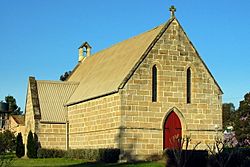St John the Evangelist Church, Wollombi facts for kids
Quick facts for kids St John the Evangelist Church |
|
|---|---|
| St John the Evangelist Anglican Church | |
| St. John's Wollombi | |

St John's Wollombi, pictured in 2007
|
|
| 32°56′15″S 151°08′26″E / 32.937603°S 151.140485°E | |
| Location | 2985 Paynes Crossing Road, Wollombi, City of Cessnock, New South Wales |
| Country | Australia |
| Denomination | Anglican Church of Australia |
| History | |
| Status | Church |
| Founded | July 1846 |
| Founder(s) | Most Rev. William Tyrrell |
| Consecrated | 15 February 1849 |
| Architecture | |
| Functional status | Active |
| Architect(s) | Edmund Blacket |
| Architectural type | Church |
| Style | Old Colonial Gothic Picturesque |
| Years built | 1846–1864 |
| Specifications | |
| Capacity | 160 worshipers |
| Materials | Hawkesbury sandstone |
| Administration | |
| Parish | Wollombi Valley |
| Diocese | Newcastle |
St John the Evangelist Church is a very old and important Anglican church in Wollombi, New South Wales, Australia. It is located at 2985 Paynes Crossing Road. This beautiful church was designed by a famous architect named Edmund Blacket. It was built between 1846 and 1864.
Contents
History of St John's Church
In May 1845, people living in the Wollombi area decided they wanted to build a church. By 1846, they had chosen an architect and the government had given them land. They also started looking for builders to work with stone and wood.
Who Designed the Church?
The church was designed by Edmund Blacket. He was a well-known architect who arrived in Australia in 1842. St John's Church was one of his first projects here.
Building and Opening the Church
The first stone of the church was laid in July 1846. The church was officially opened and blessed on February 15, 1849. This ceremony was led by Bishop William Tyrrell, who was the Bishop of Newcastle at the time.
Church Extensions
Between 1862 and 1864, the main part of the church, called the nave, was made longer by about 6 meters (20 feet). Edmund Blacket also designed and oversaw these additions. A photo from 1920 shows that the church was built in 1847, extended in 1864, and could seat 160 people.
What St John's Church Looks Like
St John the Evangelist Church is a simple, charming village church. It was built in a style called Old Colonial Gothic Picturesque. This style uses elements from old Gothic churches but makes them fit a more natural, scenic setting.
Church Design and Materials
The church has a rectangular shape. It has a porch that sticks out, a vestry (a room for clergy), and a chancel (the area around the altar). These parts are lit by tall, narrow windows called lancet windows.
The roof is made of iron and has a simple pointed shape. At one end of the roof, there is a small bell tower. At the other end, there is a stone cross. The church is built from local Hawkesbury sandstone. This stone has a lovely golden color with different shades.
Inside the Church
Inside, the church has beautiful fittings and pews (church benches) made from fine cedar wood. To get to the church, you walk through a classic picket fence. There is also a lovely old wrought iron lantern at the entrance.
How Well is the Church Preserved?
The church is in excellent original condition. Most of the building is still the same as when it was first built. This includes the changes made, like the longer nave and any repairs. It is very well-preserved and looks much like it did when it was new.
Why St John's Church is Important
St John the Evangelist Church is very important for many reasons. It is well-preserved and looks beautiful in the valley.
Historical Importance
The church is important because it shows how successful and hopeful people were in the area long ago. It also shows how important Wollombi was when the Great North Road was a major route.
Connection to a Famous Architect
This church is historically important because it was designed by Edmund Blacket. It was one of his first projects in New South Wales. This makes it a special example of his early work.
Beautiful Design and Location
The church is beautiful because of its design. It uses local stone, which adds to its charm. Its location in the landscape also makes it very pretty.
Community Value
The church is important to the community. It has provided spiritual and social support to people in the area since the 1840s. It still does so today.
Research Opportunities
The church is also important for research. Because it is an early work by Edmund Blacket, it helps us understand his architectural style. It also has a marker showing the level of a big flood in 1949. This marker has been useful for planning in the area.
A Great Example of Early Churches
St John's Church is a good example of Blacket's early work. It also represents the types of local churches found in small towns in the early 1800s.
See also
- Australian non-residential architectural styles
- List of Anglican churches in New South Wales
Images for kids



